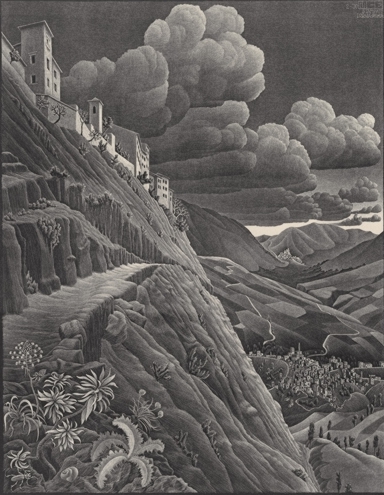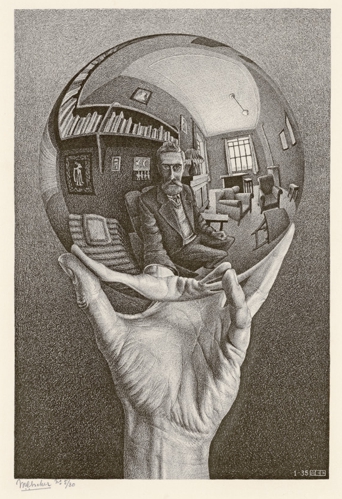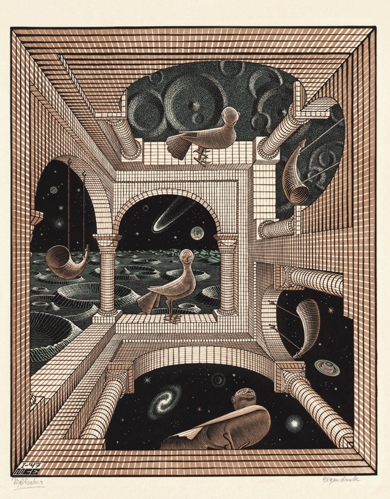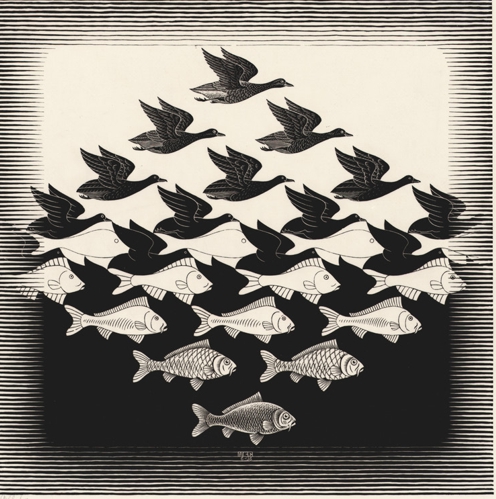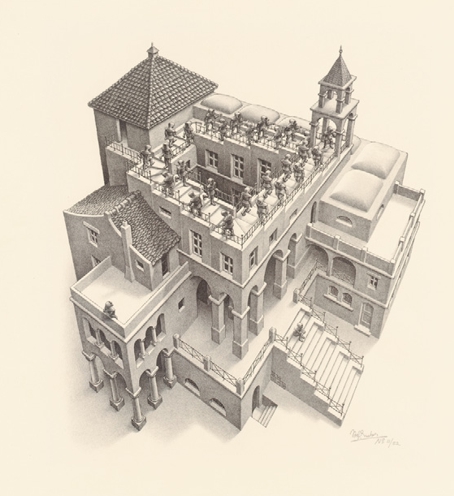M.C. Escher
Biographie:
The Magic of M.C.Escher
M.C.Escher’s famous prints, with their intriguing mixture of art, fantasy,and mathematics, are among the most memorable images of our time.
His magical, interlocking fish, reptiles, birds and reptiles made him one of the most popular artists of the 20th century.To look at M.C.Escher’s work means a journey into a unique, enigmatic world and has fascinated people around the world.
His art, with its extraordinary manipulations of space, time and perspective, becomes ever more popular and sought after. No artist ever worked harder to render the visions of his mind’s eye. The visions themselves were remarkableenough: for Escher, the skin of the visible world was nothing more than a pieceof cloth that could be cut, folded, shaped and rearranged in marvellous ways.A superb draughtsman, he set himself the challenge of portraying theseotherworldly transformations of space within the familiar borders establishedby a sheet of paper. The resulting images have become the favourite artworksof hundreds of thousands of viewers.
In his own words, Dutch born M.C.Escher, who lived from 1898 to 1972, saidabout his work: „I try in my prints to testify that we live in a beautiful and orderlyworld, not in a chaos without norms, even though that is how it sometimesappears. My subjects are also often playful: I cannot refrain from demonstratingthe nonsensicalness of some of what we take to be irrefutable certainties.
It is, for example, a pleasure to deliberately mix together objects of two orthree dimensions, surface and spatial relationships, and to make fun of gravity.“
Dr. Doris Schattschneider, a famous American Professor of Mathematics, wrote in an introduction to a book on Escher’s work: „Everyone loves surprises.There are two types of surprises – the one is a happy accidant or coincidence;the other is meticulously planned, perhaps cunningly disguised to appear natural,and brings double pleasure. It is often hard to say who has greater delight – the person who is surprised or the one who devised the magic.
The Dutch artist M.C.Escher was an ingenious planner of many surprises of thesecond kind. His graphic art fairly bursts with cunningly planned visual surprises.At first glance, much of his work appears natural, yet, at second glance, the seeminglyplausible is seen to be impossible and the viewer is drawn to look again and againas he discovers with delight the hidden surprises the work contains.How did Escher do it? He was a genius of imagination, a skilled graphic craftsman,but the key to many of his surprising effects is mathematics. Not the mathematicsof numbers and equations that most of us envision, but geometry in all aspects, bothclassical and modern.“
J.L. Locher, author of many books about the work of Escher and a former director of the Gemeentemuseum, The Hague, Netherlands, which holds the largest collectionof Escher’s work, wrote in his book „The Magic of M.C.Escher“:
„In his famous images Escher often presents a picture-puzzle. How can a level field evoke depth or height, as well as surface? How can something be both inside and outsideor both convex and concave? By looking carefully and by penetrating into the logic ofthe image every viewer is able to find the solution, and this looking and finding by seeking is fascinating. What is striking is that the solution is always purely a virtual one: both the question and the solution hold us captive in the image.
Escher’s unique interplay between inside and imagination, between possible and impossibleworlds, has given his body of work a wholly personal presence in the panorama of the visual arts“
“ All M.C.Escher Works © The M.C.Escher Company B.V. – Baarn – The Netherlands. Reproduced by permission. All rights reserved. www.mcescher.com“.




